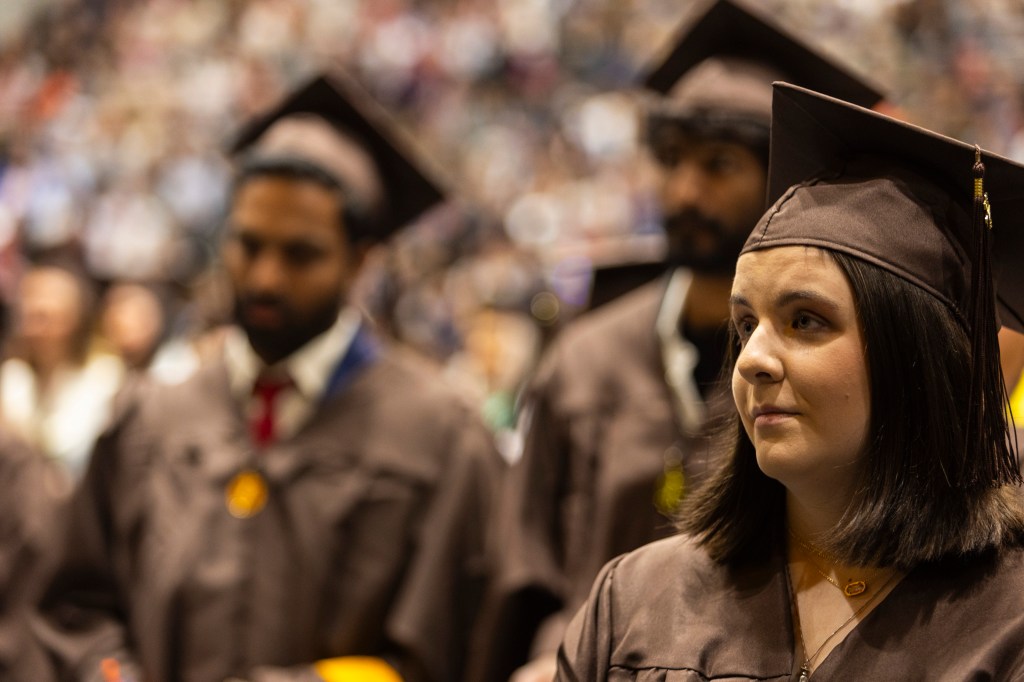Hoosiers attending Indiana colleges as undergraduates this year increased slightly from 2023, while enrollment from out-of-state students increased by nearly 6%, according to data released last week by the Indiana Commission on Higher Education.
State higher education officials said enrollment at all its institutions showed the largest one-year increase since 2010. The increase was about 2%.
It marked the straight second year college enrollment increased, reversing the previous 12-year decline.
Over the past five years, Indiana students going to college declined 9.8%, while enrollment among non-residents increased 17.4%.
The in-state numbers have sounded alarm bells among state officials with the number of Indiana high school graduates heading to college hovering around 53% for the past four years.
In a May state report, the Commission on Higher Education said it’s undertaking research to examine why high school graduates are skipping college. Officials hope to develop policies to stem the trend to reverse Indiana’s low college attainment rate that’s in the bottom five in the country.
One early conclusion from the research is students perceive college is unaffordable.
Officials have been stressing the affordability of Indiana’s universities and highlighting success with the recent 80% participation rate in the state’s 21st Century Scholars program, which covers tuition at state public colleges. Those students entered directly after high school.
A 2023 state law, authored by State Rep. Earl Harris, D-East Chicago, automatically enrolls eighth graders into the 21st Century Scholars program, which began in 1990. It included more than 40,000 students last year.
“Helping students get enrolled in the 21st Century Scholars program will not just help individual students and their families, but the state as a whole by helping us build a skilled, 21st Century economy,” Harris said last year.
Economists have warned Indiana’s low college attainment rate will slow its growth and accelerate a brain drain.
In a recent opinion column in the Indianapolis Star, Michael J. Hicks, director of the Center for Business and Economic Research and an economics professor at Ball State University, blamed decreased state higher education spending as a big part of the state’s problem.
Meanwhile, in its initial redesign of high school diploma requirements, the state Department of Education shifted the emphasis to school-to-work job training readiness and away from college preparation. The draft produced an outcry from state universities with many leaders saying the new guidelines would no longer meet their admittance guidelines.
The DOE offered up a second draft with more academic rigor that gained approval from college officials.
Hicks contends there’s no growing demand for trades jobs, which he said are at a lower number today than at the turn of the century.
He said vocational and trade education won’t replace the labor market security of a college education, citing a labor market favoring college graduates.
There were some good signs in last week’s enrollment report.
Indiana University’s main Bloomington campus set a record this fall with 48,000 students enrolled. IU officials said applications rose 25% from last year.
Purdue University’s West Lafayette campus posted an enrollment of 57,596, a 31% increase from 2019.
At Indiana University Northwest, in Gary, enrollment increased 2.9% to 2,907, but it’s experienced a 20% decline from 2019.
Enrollment at Purdue Northwest dropped 1.3% from last year to 6,444, a 23.3% decline from 2019.
At Valparaiso University, this year’s total fall headcount was 2,598 students, compared to 3,521 in fall 2019 — a 26% decrease. Only 16 students from the latter count were in the university’s law school, its last cohort before it closed.
The 2024 census enrollment summary can be found at https://bit.ly/4eRUI3G.
Carole Carlson is a freelance reporter for the Post-Tribune.


